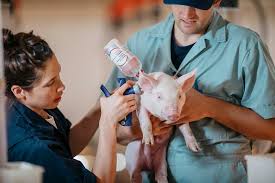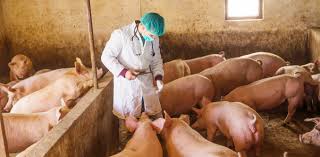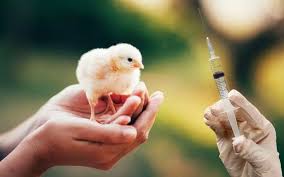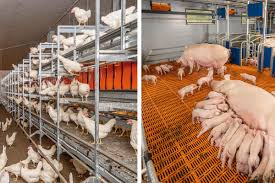Vaccination is an effective means of preventing or reducing the adverse effects of specific diseases in poultry. Poultry refers to birds kept for human use, including chickens, turkeys, ducks, geese, quails, pheasants, pigeons, guinea fowls, pea fowls, ostriches, emus, and rheas.
Disease-causing organisms are classified, from smallest to largest, as viruses, mycoplasma, bacteria, fungi, protozoa, and parasites. All these organisms, except viruses, can be treated with chemotherapy.
Control of viral diseases depends primarily on prevention through sanitation, biosecurity, and vaccination.
Vaccination Procedure in Poultry
Day-old vaccination is usually performed by administering 0.2 to 0.5 ml of vaccine either subcutaneously (under the skin at the back of the neck) or intramuscularly (into the leg). Automatic vaccination machines are commonly used in various parts of the world, particularly for neck injections.
A skilled operator can vaccinate between 1,600 and 2,000 chicks per hour. A dye is often mixed with the vaccine for easier visualization after the injection. Bent or burred needles must be replaced immediately, and needles should be changed several times throughout the day.
Pre-vaccination Requirements
- Calibrate all vaccinators to ensure accuracy.
- Confirm needle positioning.
- Provide a sufficient number of new sterile needles.
- Check vaccinators for correct dosage.
- Ensure pneumatic pressure is properly regulated.
- Check that vaccine vials are not thawed.
- Ensure the diluent has the correct color and consistency.
- Wear safety goggles and insulating gloves during handling.
Read Also: Goat Milk Production Complete Guide
Vaccine Administration

Start the vaccination process with properly sanitized equipment. Connect the diluted vaccine to the vaccination equipment and test the system before vaccinating chicks.
The standard dose administered is 0.2 to 0.5 ml. Change the needles after every 1,000 chicks. Once reconstituted, the vaccine should be used within 30-45 minutes. If the vaccination process is interrupted, track the time and avoid using the vaccine if it has been sitting for more than 45 minutes.
A sample of chicks per vaccinator can be taken to ensure proper vaccine delivery. The added dye helps check the presence of the vaccine in the subcutaneous tissue. After sampling 100 chicks, count how many show signs of dye and address any issues immediately. This inspection must be completed within 15 minutes post-vaccination as the dye fades over time.
Post-vaccination Steps

- Clean, sanitize, and sterilize all vaccination equipment at the end of the day.
- Discard any unused vaccine, including those left unused during personnel breaks.
Spray Vaccination with Backpack Spray System
To perform spray vaccination, move slowly, starting at one end of the poultry house and making two complete passes. One person should walk ahead to part the birds and prevent them from crowding the back wall.
Each vaccinator sprays one side of the house, holding the nozzle three feet above the birds’ heads. Maintain constant pressure at 4.5 to 5.0 Bars (65-75 PSI) throughout the process.
Water Vaccination Process
Reconstituted vaccine is poured into the drinkers or released from a water tank or proportioner. Ensure birds drink all the vaccine solution within two hours, but no sooner than one hour.
- For water tanks, open the valve for birds to consume the vaccine and restore normal water flow afterward.
- For water pumps, mix the vaccine, stabilizer, and dye in a container, then pump it into the drinker lines. When the dye is visible at the end of the line, close the end and lower the drinker lines for consumption.
Intraocular (Eye Drop) or Nasal Drop Vaccination
Vaccination is successful if the drop (0.03 ml) is absorbed into the eye or nasal cavity. Wait a few seconds after administration to ensure the drop is fully absorbed before releasing the bird. If absorption is incomplete, administer another drop.
To prevent the vaccine from warming against the vaccinator’s hands, divide the reconstituted vaccine into two or three vials, alternating their use and keeping the remaining vials in a cooler with ice.
Wing Web Vaccination Procedure
The vaccine is administered in the center of the wing web using a two-pronged needle applicator. Feathers must be removed from the wing web before vaccination, and care should be taken to avoid blood vessels, bones, and feathers. Change needles every 500 birds and replace the needle immediately if the wing vein is punctured.
Instructions for Vaccine Administration Sites
1. Breast: Inject into the superficial pectoral muscle, 1 to 1.5 inches lateral to the keel bone, aiming the needle at a 45-degree angle to avoid piercing the body cavity.
2. Tail Head: Inject below the tail head, directing the needle to the side of the tailbone and avoiding rapid withdrawal to prevent vaccine leakage.
Read Also: Worm Infestation on Ruminant Animals: Symptoms and Treatment
General Vaccine Handling Instructions

- Vaccines should arrive with cool packs in a well-insulated box.
- If a vaccine arrives hot, contact the manufacturer or distributor.
- Storage temperature must be maintained between 35-45°F (2-8°C).
- Avoid freezing, overheating, and exposing the vaccine to intense light.
Live Vaccines
Transport live vaccines to the farm in coolers with ice packs to maintain a constant temperature. Reconstitute with diluent just before administration.
Inactivated Vaccines
Remove inactivated vaccines 24 hours prior to use to allow them to warm to room temperature. Alternatively, a warm water bath can be used, but the temperature should not exceed 100°F for more than five hours.
Strict sanitation and biosecurity are critical for successful poultry production. Vaccination alone cannot substitute for effective management practices. Vaccines can reduce clinical disease but may not prevent exposed birds from becoming infected or shedding disease organisms.
Do you have any questions, suggestions, or contributions? If so, please feel free to use the comment box below to share your thoughts. We also encourage you to kindly share this information with others who might benefit from it. Since we can’t reach everyone at once, we truly appreciate your help in spreading the word. Thank you so much for your support and for sharing!
Read Also: The Effect of Heat Stress on Animal Productivity
Frequently Asked Questions
We will update this section soon.

